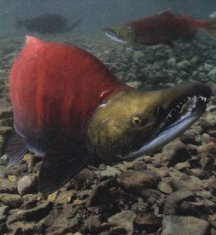|
|
Josiah Pinkham discusses the seasonal cycle, which was characterized as a "transhumance," rather than "nomadic" pattern. (Interviewed by Rodney Frey, March 2002) |
Since time immemorial and with an extensive and intimate knowledge of the animals, plants and fishes, the Nimíipuu have successfully traveled the seasonal cycle within their aboriginal territory. The seasonal round was "transhumance" in nature, a deliberate and calculated movement by Nimíipuu families to each of the rich fish, root and animal foods available during the season; it was anything but a random "nomadic" existence.
While identifying a variety of ways of marking time, it is the activities of the plants, animals and humans, each in close interaction with one another, that most distinguishes the character of the Nimíipuu calendar.
|
|
Josiah Pinkham discusses the lessons accociated with the use of the tuukas, digging stick. (Interviewed by Rodney Frey, March 2002) |
With four seasons and twelve moons generally recognized, we can begin the journey with the end of the winter and the dawn of a new year, 'elwéht (spring) and the months of latíit'al "First flowers bloom" (March) and qeqit'ál "Time to dig keh-kheet roots" (April). The names of the moons are closely linked to the activities pursued at that time of the year. While coming out of the winter with some foods having become scarce, the Nimíipuu families begin traveling during the spring in small mobile groups and are welcomed by the flowering of the first root foods. It is the beginning of root digging season.
|
|
Josiah Pinkham discusses the making of traditional cornhusk bags and more modern yarn bags. (Interviewed by Rodney Frey, March 2002) |
Among the important roots dug by women are cous (Lomatium cous), wild carrot (Perideridia gairdneri), bitterroot (Lewisia rediviva), and the blue-flowering camas (Camassia quamash). The digging stick is called a tuukes. Cous is grounded with a stone píley (pestle) and can be made into a handcake called, capkíicey. Besides being an important part of the summer diet, large qualities of roots are prepared for storage in finely coiled basketry and preserved in earthen cache pits for later retrieval. In addition, cornhusk bags were made to collect roots and to store various items.
Today glass jars are used to store the prepared roots. For additional discussion on cornhusk bags, see Contemporary Artists: Continuities
|
|
Josiah Pinkham continues discussing what goes into the making of traditional cornhusk bags. (Interviewed by Rodney Frey, March 2002) |
As the fishing season is soon to arrive, families also begin to group together in preparation of the larger summer camps. The month of May is called, 'apa'ál, the "Time to dig cous roots." As with the elk hunted and the salmon fished, children were taught not to take the largest root they came upon (or elk or salmon they found). Allow the strongest and largest root or elk or salmon to continue to live so they would help perpetuate the health of all the roots, elk and salmon.
|
|
Josiah Pinkham discusses the roles of men and women and importance of roots, such as qeqíit and qáaws, which can be made into
capkíicey, "Indian cookies." (Interviewed by Rodney Frey, March 2002) |
With the summer, táyam, and the months of tustimásat'al "Late season for cous roots" (June), q'oyxc'ál "Time of blueback salmon at Wallowa Lake" (July), and waw'a'máayq'ál "Chinook salmon to headwater's and spawn" (August), the Nimíipuu are living in large summer camps with an abundance of a variety of foods. Fishing is done along the rivers, with berry gathering and root digging continuing throughout summer. Building scaffolds out over the waters of the rivers and using spears, dip nets, weirs, and hook-and-line methods, the chinook, coho, chum, and sockeye salmon, along with cutthroat and steelhead trout, whitefish, sturgeon and eel, all found in abundance in the rivers and creeks, was an essential component to the Nimíipuu diet. Each year, an individual, on average, would consume over 500 pounds of fish (Walker 1998:420). Salmon could be dried and grounded into a high-energy powdered meal, called, tánat. A small amount could sustain an individual for several days.
|
|
Josiah Pinkham discusses the use of the píley (grinding stone) and use of powdered salmon and berry foods. (Interviewed by Rodney Frey, March 2002) |
An important teaching associated with fishing called for cleaning the fish along side the rivers and discarding the entrails into the waters. Along with the decomposing of dead salmon each year upon their return from the ocean, the fish entrails added much needed nutrition to the life of the streams.
|
|
Jack McCormack discusses the continuing role and importance of salmon for his family. (Interviewed by Dan Kane, September 2001) |
Continue the seasonal round by traveling to Seasonal Round: Summer into Winter.
© Nez Perce Tribe 2002
< previous |
next > |














